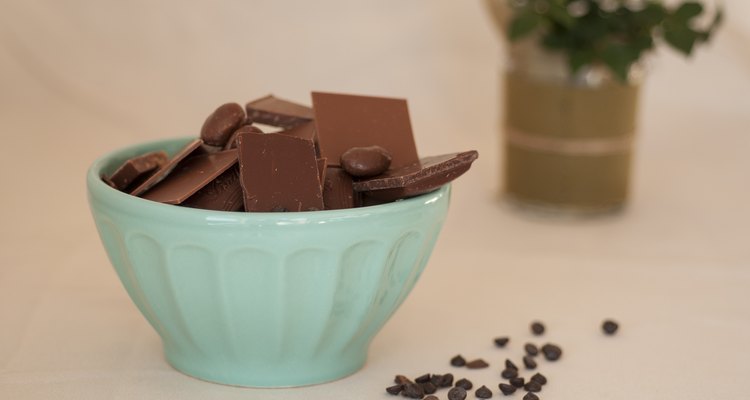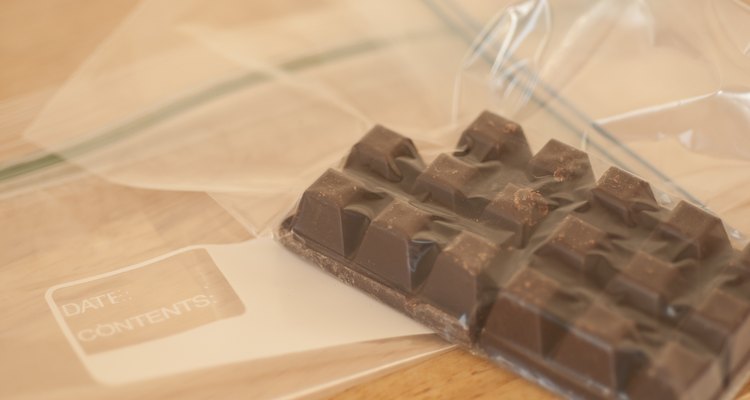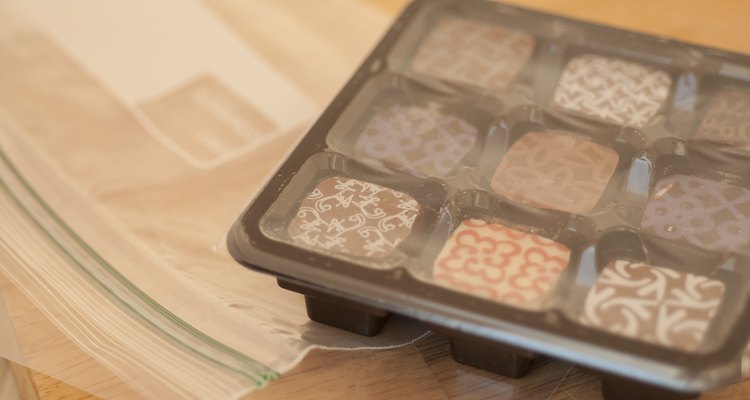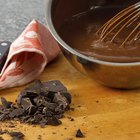
Enthusiasts might argue that there's no such thing as "too much chocolate," but it's certainly possible to have more on hand than you can conveniently use or eat. Chocolate has a rather extensive shelf life, depending on its purity, but eventually it develops a "bloom" of crystallized cocoa butter on the surface. It can be frozen, as a means of prolonging its storage life, but the quality will suffer unless you do it right.
Plain Chocolate

Chocolate stores best at temperatures of 65 to 70 degrees Fahrenheit, according to food science writer Harold McGee, but few kitchen cupboards provide that ideal environment. If you find that chocolate in your pantry melts or blooms, freezing may be the better option. Packaging it as airtight as possible is crucial, because any moisture in the air can cause problems later. Portion the chocolate into zipper-seal freezer bags, or use a vacuum food sealer if you have one. Chill your chocolate first in the refrigerator for several hours, and then freeze it. When you need the chocolate for baking or candy making, let it thaw in the refrigerator overnight. At room temperature, condensation could form and cause the chocolate to "seize," ruining it for dipping and candy making.
Chocolate Candies

Homemade truffles and other chocolate-based candies are usually unsuitable for freezing, because fondant, caramel and some ganache centers become grainy and unpleasant when frozen and thawed. It's best to experiment with one or two candies before freezing a whole batch. Boxed commercial chocolates are best if frozen in their original packaging, ideally with plastic film or a heavy-duty freezer bag as an over-wrap. If they've been opened, vacuum-seal the individual candies -- in their paper cups, if possible -- or package them into small zipper-seal bags. As with solid chocolate, thaw them overnight in the refrigerator to minimize the risk of condensation.
Related Articles

Difference Between Baking & Eating ...

Which Country Produces the Most ...

How to Make Chocolate-Covered Graham ...

How to Melt Hershey's Chocolate

How to Make Chocolate Sculptures

How to Make Chocolate Ganache With ...

Ganache Substitute

How to Make Your Own Chocolate Truffles

How to Make Cakes With Candy Baked ...

How to Make Chocolate Vodka

How Long Can Cupcakes Be Stored After ...

Can You Substitute Semi Sweet Morsels ...

FDA Standards of Chocolate Identity

The Uses for Dry Fondant

How Do I Preserve Buckeyes?

Do You Need to Refrigerate Whipped ...

Cupcake Decorating Ideas Without ...

Substitute for 1 Square of Baking ...

How Early Can You Make a Wedding Cake?

Can You Use Heavy Cream When Making ...
References
- On Food and Cooking: The Science and Lore of the Kitchen; Harold McGee
- Serious Eats: Serious Chocolate -- How to Store Chocolate
Writer Bio
Fred Decker is a trained chef and prolific freelance writer. In previous careers, he sold insurance and mutual funds, and was a longtime retailer. He was educated at Memorial University of Newfoundland and the Northern Alberta Institute of Technology. His articles have appeared on numerous home and garden sites including GoneOutdoors, TheNest and eHow.
Photo Credits
kayako sareen/Demand Media